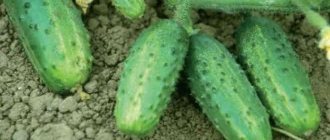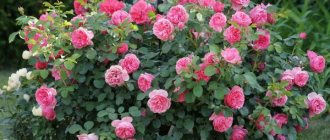Description of the Iceberg variety
Iceberg rose is a resistant plant that is extremely rarely infected with fungal diseases. The plant is very frost-resistant, is located in the fourth zone, and can grow in regions where the temperature drops to -35 degrees.
The crop does not like high humidity; in the rain, the flowering of the bush decreases. The growing season of the variety begins in March. The rose blooms until late autumn, with the first buds blooming in June. The variety is classified as a climbing plant, but in the international register the Iceberg rose is listed as Floribunda.
| Color | White |
| Number of flowers per stem | From 5 to 10 |
| Aroma | Weak |
| Flower size | 5-7 cm |
| Bush height | 240-450 cm |
| Bush width | 100-250 cm |
| Frost resistance | Frost-resistant, zone 4 |
| Powdery mildew resistance | Very good |
| Black spot resistance | Very good |
| Rain resistance | Average, in rainy weather not all buds open |
| Bloom | Reblooming |
| Bush shape | Spreading |
| Flower | Semi-double |
Disease and pest control
The Iceberg climbing rose, growing in warm and dry climates, is characterized by high resistance to most pests and diseases characteristic of the crop. However, with excess moisture, the plant may be at risk of black spotting. It usually appears due to stagnation of groundwater in the soil or after prolonged heavy rains. The first signs of the disease are black or brown spots on the leaves, which can have a variety of shapes.
Important! If symptoms are detected, it is necessary to treat the bush with fungicides as soon as possible; after half a month, the procedure should be repeated.
Appearance and features
Rose Iceberg is a delicate, exquisite flower with an open, cup-shaped shape. When not fully opened, the buds look like miniature classic hybrid tea roses. The blossoming bud unfurls its thin petals and reveals a core with bright yellow stamens.
The petals are slightly wavy, snow-white without impurities. Iceberg roses bloom in round clusters of 5-10 pieces. The plant blooms profusely; under favorable conditions, the bush is covered with a scattering of large, white clusters.
Flowers do not fade in the sun, but deteriorate due to prolonged rains. The disadvantage of the Iceberg variety is its weak aroma; many flowers on the bush emit almost no scent.
The Iceberg variety shrub can grow from 2.5 to 4.5 meters. The shoots are flexible, thin, green in color and difficult to see due to the abundance of foliage and flowers. The bush is spreading and can trail along a support.
The perennial quickly grows young shoots. The foliage on the stems is wide, elongated, pale green or dark green, depending on the lighting.
Reviews of Rose Iceberg
Tatyana Georgievna, 56 years old, Vladikavkaz
Rose Iceberg is my favorite, which has been wintering for the sixth year in a row; my husband gave me seedlings for my anniversary. With it, unlike other varieties, I never had any problems. The only negative is the weak aroma, but what a look!
Antonina Sorokina, 40 years old, Ulyanovsk
Despite the fact that I planted the Iceberg rose in partial shade, it blooms perfectly. Its buds are large, the bush is tall and very branched. I can say from my own experience that after long rains it is necessary to shake off the flowers, otherwise the plant will get sick.
Photo
love.beautiful_life
_rosesmol_
ann.net.ta
sl.030
tanbessad
Reproduction methods
The climbing white rose "Iceberg" can be propagated in a variety of ways:
- cuttings;
- seeds;
- layering;
- vaccinations.
Most often, gardeners propagate this crop by layering and cuttings, since they demonstrate better survival rate. When propagated by seed, the plant grows with a partial loss of varietal characteristics.
Planting climbing rose "Iceberg" with seeds is a less effective way
Diseases
Does the rose have a gray-white coating or brown balls on the leaves? Methods to combat the disease.
Powdery mildew
Black spots of a round shape have appeared on the leaves of the rose, what should I do, how can I save the plant?
Black spot
The rose is sprinkled with yellow powder, the leaves and stems crack and die, how to get rid of the disease?
Rust
Has a gray coating appeared on the rose? This is gray rot that needs to be gotten rid of as soon as possible.
Gray rot
Planting in lowlands will cause root rot and the appearance of fungal diseases. High air humidity negatively affects the plant, so this indicator should be moderate. You cannot plant shrubs in a draft.
It is recommended to choose light, drained, fertile soil. Clay soil needs to be loosened with sand, sandy soil with clay and sawdust. Before planting, you need to treat the seedling, shorten the roots, the length of which is more than 30 cm, and trim the shoots, leaving 3-4 shoots.
The depth of the planting hole is from 70 to 90 cm, the width is 70 cm. The Iceberg variety shrub should be placed close to a wall or other support, at a distance of at least 30 cm. A distance of 150-200 cm must be maintained between bushes of the same variety.
At the bottom of the planting hole you need to lay out drainage and a soil mixture of sand, turf soil and humus in a ratio of 2:1:1. After preparing and settling the hole, you can begin planting. The seedling is lowered into the hole, the roots are straightened and covered with earth above the grafting site. The area needs to be compacted and watered moderately.
High-quality watering is important for Iceberg roses. The crop should be moistened exclusively at the root using warm water. Drops should not fall on leaves, buds and shoots, otherwise burns will appear on them.
To avoid burns, it is recommended to water only in the evening or morning, when there is no scorching sun. Watering should be carried out regularly, preventing the soil around the bush from completely drying out. Young bushes need to be watered more often than older ones.
The plant needs to be fed with organic fertilizers. They are introduced into the soil through mulching. When decomposed, fertilizers will saturate the soil with useful substances. Manure, humus and peat can be used as mulch.
Mulching is carried out in spring and autumn; every season you need to change organic matter, alternating it. It is also necessary to use mineral fertilizers. In May, Iceberg is fertilized with nitrogen; at the end of summer, phosphorus and potassium are required.
The plant needs to be pruned in spring or autumn. If pruning was carried out in the fall, then in the spring the procedure does not need to be repeated. Do not prune old shoots. Without timely pruning, a climbing shrub will quickly turn into a shapeless, sloppy plant. You can replant the shrub in the fall if the roses in the old place do not bloom well or the roots have become crowded.
Application of Iceberg rose in landscape design
The use of the Iceberg climbing rose is widespread, not for cutting, but for decorating a garden or summer cottage. It can also be used in the landscape design of streets, squares and parks. Since the variety is characterized by long flowering periods, high winter hardiness and unpretentiousness, it is often planted even as a border.
Iceberg climbing rose is often used for planting as part of hedges and woodlands. The variety also performed well when grown on a trunk: grafting is carried out at a height of 100 - 120 cm, the crown of the crop is formed in the form of a ball with a diameter of about 60 cm.
The Iceberg climbing rose with snow-white flowers looks very impressive when creating gardens in monochrome shades. Landscape designers especially recommend this technique for small areas, for which it is important to create the illusion of increasing space through color solutions.
Pests
Mole crickets have appeared in the garden, this is very dangerous for your flowers, find out how to get rid of the pest
Medvedka
Several sources of foamy liquid have been observed on the rose bush; this is a dangerous pest.
Slobbering Penny
Rose Iceberg is not afraid of severe frosts; in the southern regions with warm winters, the bush does not need to be covered. In cold winters, it is recommended to hide the rose to avoid freezing of the roots and young shoots. The bush must be bent to the ground and covered with non-woven material or cardboard. With the onset of warmth, the plant needs to be opened and the ground mounded to restore oxygen circulation.
Rules of care
Basic rules for caring for the Iceberg climbing rose:
- The soil should be well moistened and not dry, but excess moisture should not be allowed. The plant is watered directly at the root. It is important to ensure that when watering, water does not fall on the flowers and leaves; under the bright sun this can cause burns.
- The plant prefers organic fertilizers. Fertilizers are applied according to the mulching principle, laying them out in layers near the tree trunk; over time, the mulch decomposes and begins to nourish the bush. Dry peat, humus or compost can be used as fertilizers. This fertilizing is usually carried out in the fall, since it allows you to additionally protect the plant from the cold.
- In summer, fertilizer is applied twice. The best option during this period is to use ammonium nitrate or complex mineral fertilizers with nitrogen.
- The plant needs shaping, otherwise the shoots will grow in a chaotic manner, giving a careless appearance to the bush. The procedure is carried out in autumn or spring. During pruning, old shoots over the age of three years, which are no longer capable of flowering, are usually removed. Last year's shoots are shortened by 3 buds so that the bush blooms more luxuriantly.
The Iceberg climbing rose variety belongs to the 5th winter hardiness zone and can withstand frosts down to 29 degrees below zero, but the bush still needs shelter for the winter. Then, in the event of a sudden onset of severe frost, you don’t have to worry, since the plant will be under reliable protection.
To build a winter shelter, the shoots are pressed to the ground and secured, after which spruce branches, agrofibre or other materials are laid on top. In the spring, the cover is removed, otherwise the bush may rot.
Useful tips
- Before planting, a seedling of the Iceberg variety must be immersed with its roots in a growth stimulator for 3-5 hours;
- Mineral fertilizers and wood ash have a beneficial effect on Iceberg rose. You can replace store-bought fertilizers with homemade tinctures. As a natural mineral fertilizer, use 2 buckets of fresh nettle infused in 20 liters of warm water;
- The shrub rarely gets sick, even widespread powdery mildew almost does not affect the plant. If a characteristic coating appears on the leaves, the plant must be treated with special chemicals. Powdery mildew affects the plant only at high humidity.
Advantages and disadvantages
Among the main advantages of the variety:
- abundant and long flowering;
- snow-white color of the petals;
- beautiful dense foliage;
- high winter hardiness;
- unpretentiousness;
- disease resistance;
- Possibility of use for vertical gardening and other tasks.
Disadvantages include only a weak aroma and susceptibility to black spotting in high humidity conditions.
The bush looks great as a tapeworm, in flower beds and rose gardens, combining well with other flowers of rich contrasting color
If you choose the right place for planting and follow standard care recommendations, Iceberg climbing can become the main decoration of the garden.
Characteristics and description
Rose William Morris - characteristics of culture
The description of the Iceberg hybrid tea rose should begin with the inflorescences: they have a white or cream color with a yellow core, the color changes with lowering temperatures and becomes pinkish. The surface of the petal is semi-double, the diameter of the flower can be 9 cm. Each stem has 2-3 buds.
Despite the lack of aroma, this rose is a regular in any garden. A shrub 1-1.5 meters in height instantly wraps its shoots around a wall or facade.
Brief characteristics of the plant
| Color | White, cream, pearl |
| How many inflorescences are there on a shoot? | From 2 to 5 |
| Presence of aroma | Unsaturated |
| Inflorescence diameter | From 7 to 9 cm |
| Height | Up to 1.5 m |
| Shrub width | Up to 1 m |
| Where is it grown in Russia? | Krasnodar region, Rostov, Kuban, Samara, Ryazan, Saratov, Moscow region, St. Petersburg and Yaroslavl |
| Winter hardiness | High |
The climbing rose Climbing Iceberg has very lush, beautiful blooms.
Iceberg Floribunda rose blooming
Iceberg's growing season begins in March. After wintering, the culture awakens and begins its growth and development. In June, the inflorescences bloom - this is the next stage, flowering, which lasts until the autumn frosts. Sometimes it happens repeatedly during the season. In areas where there is no winter, the rose will bloom all year round.
Bloom
When and how does it happen?
It blooms all summer until late autumn - continuously and abundantly.
Care before and after
Features of the plant. The snow-white beauty loves sun, well-drained soil and moderate humidity.
What to do if it doesn't bloom?
- Diseases - to prevent dangerous diseases, even at the stage of dormant buds, you should irrigate the bushes with 1% Bordeaux mixture. It is also necessary to provide the plant with potassium fertilizers. Affected branches and lack of shelter for the winter can also cause a lack of flowering.
Wild growth . It is necessary to regularly and promptly remove shoots from the root zone.- Excess nitrogen supplements . Such feeding provokes an increase in green mass, and this negatively affects the setting of buds.
- Wrong landing site . This can lead not only to a lack of flowering, but even to the death of the flower.
- Incorrect pruning . It is important to observe moderation here, do not overdo it - having captured many young shoots, the rose will not be able to recover and will not form buds.
- Unfavorable soil composition . The soil should be loose, fertile and contain useful substances.
Growing and planting in open ground
Agricultural techniques for roses are similar for many varieties. But it is worth considering that neglecting at least one rule for caring for a plant can lead to slower growth and worse flowering.
Saplings
Rosa Ali Baba (Alibaba)
The purchase of planting material should be treated very responsibly.
Important! You should not save money and purchase rose seedlings from unverified sellers. It is better to make a purchase at a nursery or garden center
Before purchasing, you should carefully inspect the plant. There should be no signs of disease, the leaves should be shiny and evenly colored. If possible, it is necessary to inspect the root system. It should be well developed and not have damaged or dried roots.
It is better to purchase seedlings that have reached the age of 2-3 years. Their survival rate is higher due to a more developed root system.
Boarding time
When determining planting dates, you should focus on the climate. In regions with a temperate climate, both spring and autumn are suitable for planting.
In more severe climatic conditions, planting can also be carried out in both spring and autumn. However, the timing will vary. In the spring they should be shifted to a later date, and in the fall - to an earlier date.
The average planting time in spring is mid-April - mid-May, for autumn - late August - September.
Important! It is very important to observe the timing of planting seedlings, especially for regions with a cold climate, such as Siberia. Planting too late or too early risks losing the plant.
Selecting a location
Like many other repeat-blooming roses, the Iceberg climbing rose prefers sunny places, protected from strong winds and drafts.
You should also avoid places close to groundwater and stagnant melt water. Rose roots do not tolerate waterlogging; this threatens them with rotting and the development of fungus.
Planting too close to the walls of buildings is also not recommended. There must be a gap between the support with shoots and the wall for free air circulation.
Note! You should not plant seedlings in the place of previous rose growth. The soil in such areas is not only depleted, but can also be infected with diseases.
Soil and plant preparation
Before you begin directly planting rose seedlings in the ground, it is necessary to carry out a number of certain activities.
Any rose, including the Iceberg variety, is demanding on the soil. She needs nutritious and light soil. It should be prepared before planting the plant.
The soil for planting is prepared in advance
If possible, the soil is replaced throughout the entire planting area. When digging, it is necessary to add peat, compost or rotted manure and the required dose of mineral fertilizers. It is better to do this in the fall or 2-3 months before planting.
If digging up the entire area is impossible or not necessary, the required amount of soil is prepared separately in a container. It is then used during planting to fill the planting hole.
The plant should also be prepared before planting. Seedlings in a pot are watered the day before planting to make it easier to remove from the pot.
After extraction, it is necessary to inspect the root system. Roots that are too long or damaged are cut off.
Important! 2-3 hours before planting, the young plant is placed in water
You can add a drug to it to stimulate growth.
Landing
The technology of planting roses in the ground implies a sequence of actions and precision in their implementation. How complete the growth and flowering of the rose will be will depend on this.
Planting roses must be done correctly
The process of planting seedlings can be divided into several successive steps.
- Dig a hole of such a size that there is a space of 2-3 cm between the root system and its walls.
- The prepared soil is poured in such a way that a hill is formed.
- The seedling is placed on the surface of the mound and the roots are spread over its surface.
- Fill the hole to the edge with the rest of the soil and lightly compact the surface.
- The planting is watered at the rate of 1-2 buckets per seedling.
For your information! If planted incorrectly, there may be a need for replanting, and this is unnecessary stress for the plant.
History of the variety's creation
Rose variety Iceberg also has another name - Schneewithchen. It was released in 1958 in Germany. It differs in that it can withstand significant temperature increases and changes, dry times, while continuing to actively develop and bloom.
This variety was created by crossing the branched musk rose and the hybrid tea rose. The name was given due to the abundant flowering, in which the bush looks like a huge snowy iceberg.
Rose Iceberg Climbing climbing
Note! The white rose variety is especially common among gardeners. The shrub can curl so unusually that it is often used to decorate a decorative hedge, gazebo, or flower bed in a misborder. The flowers themselves add a special ambiance and splendor to the bush.
Features of growing a flower
In order for the plant to develop normally and enjoy lush flowering, it is necessary to carry out planting work correctly.
Optimal place
It is recommended to plant the rose in a sunny place. In the shade, the crop will not bloom profusely. It is best to plant the flower on level ground or on a small hill.
It is not worth placing the crop in lowlands, since in such places there is stagnation of water.
Preparing the soil and seedlings
The rose should be planted in an area with light and fertile soil. Dense soil with stagnant groundwater is not suitable. Before planting, the soil should be loosened with sand and peat, and humus should be added.
See also
Description of the best varieties of Canadian roses, planting and care in open groundRead
The plant should be planted in a pre-prepared hole. Its diameter should be 65 centimeters and its depth 1 meter. It is worth placing a fertile mixture of humus, garden soil and river sand in the hole. These components are taken in a ratio of 1:1:2. You can also add a bucket of wood ash and 150 grams of mineral fertilizers into the hole.
A few hours before planting, the bushes should be immersed in water. It is permissible to use a growth stimulator. This stimulates the rooting of the bushes.
Planting process
To carry out planting work, do the following:
- Trim the roots of the seedlings. They should not exceed 30 centimeters in length. It is also worth removing excess shoots - there should be 3-4 pieces left.
- Carefully place the seedlings in the recesses and cover with soil.
- Water the beds moderately.










